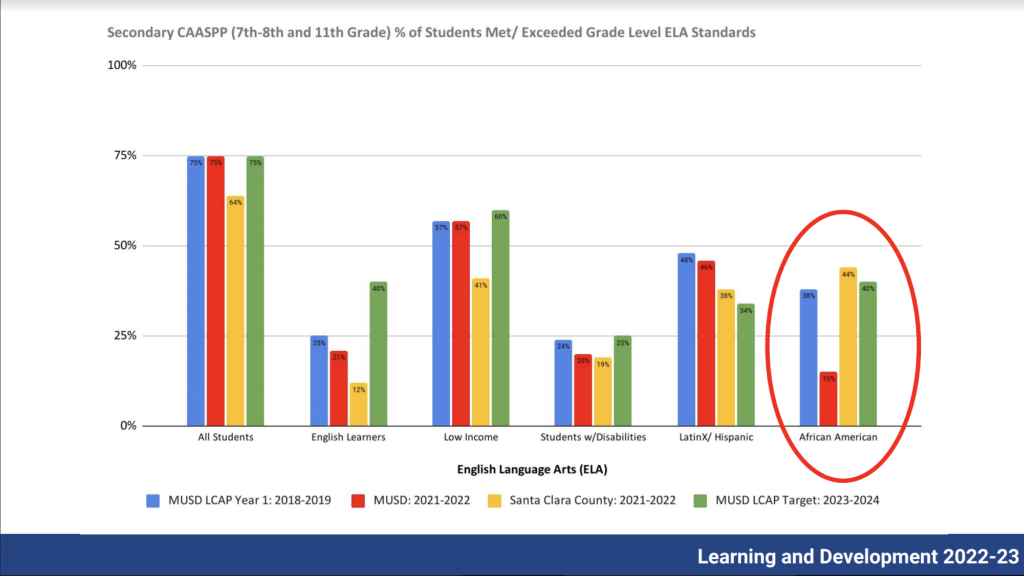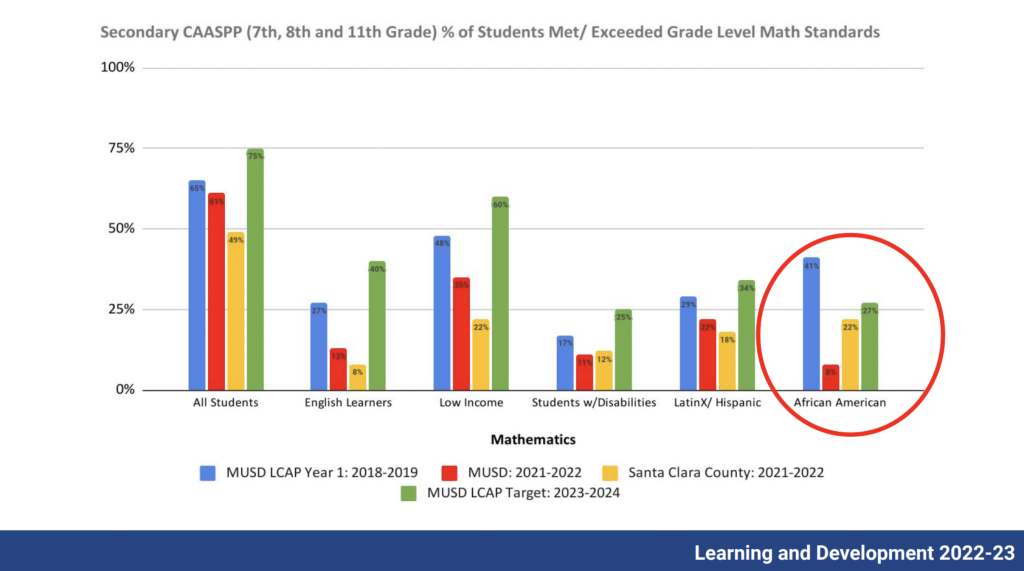There were drops in post-pandemic English Language Arts (ELA) and math California Assessment of Student Performance and Progress (CAASPP) scores among student subgroups in secondary grades, including African Americans, English learners, and low-income students, Executive Director of Learning and Innovation Priti Johari said. The test score results were presented by the Department of Learning and Development at the MUSD School Board meeting on Oct. 11, she confirmed.
Holistic data for grades seven, eight, and 11 did not show much of a drop, unlike statewide and nationwide data that did, according to Johari. Although elementary school students with disabilities demonstrated an increase in ELA test scores, there were drops for many other student subgroups, Johari added.
“We need to do a better job with our students with disabilities, our Latino students, and our African American students in comparison to where the rest of their peers are,” Johari said.
In order to address these disparities, the district is planning to introduce new brain research on how people learn to read, known as the science of reading, and pilot it with teachers and leaders, Johari said.
“There is both a component around phonics and sounds as well as comprehension,” Johari said.
“You have to be building skills in both areas to really improve your overall reading comprehension. These are areas where we are continuing to learn and build our capacity as teachers and leaders, and starting to pilot some of this work.”
MHS administration is planning to roll out professional learning communities (PLCs) in each department to assess students’ strengths and weaknesses through cycles of data investigation, Director of Secondary Education Maurissa Koide said in an email interview. Their findings will inform instructional changes, she said.
“They also discussed having the math department review the data carefully, focusing on claim areas to see if students are missing specific standards during grade 11 courses that are assessed by CAASPP,” Koide added.
Due to the diversity of students, there will always be disparities in test scores, Assistant Principal Jonathan Mach said. Since test scores are received a year after students have taken the test, interventions become outdated, he added.
“We don’t have data on current kids,” Mach said. “I wouldn’t be able to say that conclusively because you struggle with (a topic), the next class struggles with the same thing.”
The district is also trying to increase cultural responsiveness in the curriculum and school environment, Johari said. Culturally responsive practices include representing a diversity of stories in ELA and social studies curriculum and ensuring that students understand the relevance of the content, she added.
“You want to create a context for how you use this math to solve a problem that you’re interested in,” Johari said. “How do we support students to learn from each other, provide each other feedback?”
In addition, the district is working with an outside organization, Envision Learning, to design common rubrics, lead professional development for teachers, and develop deeper learning assessments through activities such as senior theses, Johari said.
“We really want to make sure that, as we are thinking about our assessments and what we’re asking students and teachers to spend time on, frankly, that it’s worth your time,” Johari said.
MHS will analyze the full data, which it recently gained access to, in order to determine its next steps, Associate Principal Skyler Draeger said. In the past, curriculum changes and tutoring programs were launched to address test score disparities among student subgroups, he added.
“For a while, we were specifically teaching things like constructed response paragraphs,” Draeger said. “The reason why those assignments were created in the first place was to address some of the areas that students weren’t doing as well on the CAASPP test in the ELA. For math, that led to a lot of change in terms of alignment with the departments.”
Additionally, the district is looking into increasing family engagement, Johari said. One way to do so is to restart affinity groups such as the African American Success Committee, she said.
“Those were committees that had educators, families, community members coming together and really thinking about how to support the needs of particular student groups in schools,” Johari said.
New strategies should monitor attendance in addition to learning, Director of Elementary Education Raquel Kusunoki said at the Board meeting. There is a correlation between chronic absenteeism and test score drops for secondary students, she confirmed.
“They can’t afford to miss any more days because of the whole year and a half of remote learning,” Kusunoki said. “We need to target specifically and catch them as soon as we can so we can give them timely support.”
Schools have begun sharing attendance data more frequently to enact focused interventions, which involve phone calls, letters, and meetings at schools before progressing to a meeting with the district if the student continues to be absent, Johari said.
“We are trying to do systemic things around multiple tiered systems of support,” Johari said.
The first tier would involve deepening advisory and social-emotional learning work, while the second and third tiers would involve restorative practices, Johari explained.
“One of the things that I want to do in the coming months is work with our Curriculum Policy Committee to really think about how we might reach back out to teachers to help understand how they are determining which students are on grade level, which students are struggling and why, and what better support like look like,” Johari said.



